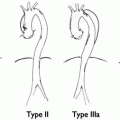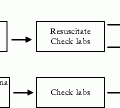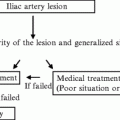Vessel
Size (mm)
IVC
20–22
Common iliac veins
14–16
External iliac veins
12–16
Common femoral veins
10–14
Stent placement in IVC can be performed from either jugular or femoral approach with deployment just above bifurcation and proceeding cephalad
Usually start with 20–22 mm diameter Wallstents in IVC
May place Gianturco (20 mm by 50 mm) stents inside the Wallstents for further support
Avoid covering the renal veins unless they are chronically thrombosed in which case retroperitoneal collaterals have already taken over
Iliac and CFV can be dilated to 14 mm (12 mm) smaller women with common iliac to 16 mm
Self-expanding stents of identical size are almost always placed
Iliac vein stents may be placed either from femoral or jugular vein approach with approximately 0.5 cm to 1 cm of overlap. While various opinions exist, we place stents such that they barely extend into IVC if the IVC is patent
If bilateral iliac stents are placed, place kissing stents at bifurcation simultaneously and into the proximal CIVs
Continue deployment in a caudal direction until you reach portion of veins that will provide sufficient inflow
Crossing the inguinal ligament has not caused problems, it is much more important to establish adequate inflow.
3.
Most venous recanalizations may be performed with conscious sedation; however, for IVC recanalizations propofol, anesthesia is helpful and general anesthesia may be required
4.
Single prophylactic antibiotic dose may be given, but stent infections have not been reported
5.
During the procedure, intravenous heparin is administered to maintain an activated clotting time between 250 and 300 seconds
(b)
Embolization of ovarian veins, IIVs, or pelvic malformations
1.
Start the procedure similar to diagnostic venography, establishing access through the groins or IJV.
2.
Embolization depends on the size of the veins and the presence or the absence of malformation and a–v shunting; usually a combination of coils, plugs, or alcohol sclerotherapy can be used.
9 Postprocedure Management and Follow-up Protocol After Stenting








